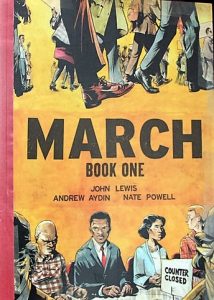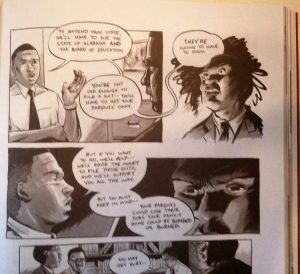
Authors: John Lewis and Andrew Aydin
Illustrator: Nate Powell
Publisher and Year: Top Shelf Productions, 2013
Number of Pages: 121
Genre: Non-fiction
 In March: Book One John Lewis tells about the struggle he has gone through and witnessed since the beginning days of segregation. He highlights the highs and lows of the Civil Rights Movement, and how much influence he had in the process.
In March: Book One John Lewis tells about the struggle he has gone through and witnessed since the beginning days of segregation. He highlights the highs and lows of the Civil Rights Movement, and how much influence he had in the process.
This book works hugely as a mirror. There are so many people that can identify with this text, and it is always helpful to get history on one’s culture. This book could work as a mirror for those who can identify with it, a window for those who can’t, and a door for those could learn a lesson from it. The 1950’s-1960’s weren’t an exciting time for African Americans, and John Lewis elaborates on that. In the beginning of the graphic novel, the Whites have all of the power. As time goes on and more Black people realize how powerful a peaceful protest could be, they begin to gain power. The use of peaceful protests is something that is still prevalent and effective today. Perceptually, the pictures mirror and add to the text, and vice versa. Most of the text is dialogue, and the rest are descriptions of scenes, people, and situations.
Structurally, the novel is set up as typical graphic novel would be: pop-out speech balloons and lots of pictures. The characters continuously move to the right, which symbolizes them moving forward. The entire book is in black and white, but the reader can still feel when a scene is “darker” than others. This may also be because the book was about problems between Blacks and Whites, so it would make sense to have the book in black and white only. Some backgrounds are white with black panels, which makes us feel lighter and less tense about what is going to happen next. Other backgrounds are black with white panels or no frames at all. There is usually a life-changing moment occurring on these pages. Ideologically, this story can serve to teach readers about African American history, if nothing else. It shows that everything does not have to be solved with violence, and that peacefully hashing things out can be more beneficial. This story also teaches readers that there are perks to being the bigger person and not letting others get to you.
